Chapter V - EURIPIDES AND VASE PAINTING
6. IPHIGENEIA AT AULIS
The story of Iphigeneia's sacrifice appears to have been
told first in the Kypria, and yet only occasional references
are made to it by writers before the fifth century. It was
the drama that infused new life into the myth and launched it
as one of the most popular ones in the Trojan Cycle. Each of
the three great tragedians tried his hand at the catastrophe
in Aulis. Euripides' work, the only one surviving, is at
least two generations younger than the play of Aischylos, so
that the wide popularity of the tragedy in this period is
well attested. Among the Roman poets we know that Ennius, at
least, wrote a version of the tragedy. Although it is known
that this poet had a special predilection for Euripides, and
for the most part translated or adapted the latter's plays,
attempts have been made to show that in his Iphigenia
Ennius was largely indebted to Sophokles. The few fragments
remaining from these three Iphigeneias are, however,
inconsiderable, and a clear notion of their relation to each
other cannot be reached. The extant work of Euripides is
accordingly of great value to us.
In art, likewise, this subject was rarely treated. I know of
no Iphigeneia monument earlier than the fifth century. There
is a reference in the Agamemnon to the sacrifice as though
Aischylos may have seen the scene represented in a painting,
and granted that the poet really had such a work in mind this
becomes the earliest date for Iphigeneia in art. The earliest
monument of which we possess any autheutic record is the
famous painting of Timanthes, who was a contemporary of
Zeuxis and Parrhasios. This date, however, does not carry one
beyond the last years of the fifth century BC. — an
altogether late date for an art representation of a myth,
which, from Aischylos' time at least, was widely known. We
have reason to believe that Timanthes' work was suggested by
Euripides' tragedy. The latter was first produced in Athens
after the poet's death, not earlier than 405 BC., and this
requires that the painting be placed near the end of the
century, which many are unwilling to admit ; it is, however,
more a matter of opinion than proof.
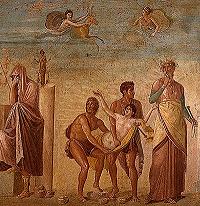 |
Traces of this celebrated picture are very probably at hand in the well-known Pompeian wall painting, and the Uffizi altar.
 |
The composition of the latter has much in common with such
fifth-century products as the Orpheus and Peliades reliefs'.
The Etruscan urns on the other hand furnish a wealth of
reliefs representing the sacrifice, rarely surpassed in this
class of monuments. Numbers have come to light in the
neighbourhood of Perugia especially. Two groups are easily
distinguishable. (1) Iphigeneia, as a little girl, is held
over the altar by Odysseus, while Agamemnon goes through the
απαρχαι. (2) The first
group is extended by (a) Klytaimestra on the side of
Agamemnon, and (b) Achilles on the side of Odysseus, each
begging for mercy and the life of Iphigeneia. This is all
non-Euripidean, and Schlie has attempted to point out that
the reliefs owe their origin to Ennius' play which combined
Sophoklean and Euripidean elements.
There is no vase painting which can be claimed for this scene
in its Euripidean character, but the whole play is the basis
of a relief on a Megarian' cup, and the illustration is so
valuable for the proper appreciation of the tragedy that I do
not hesitate to include this little monument. The cup
furnishes inscriptional evidence not only for the dramatis
personae but for the literary source as well, and is,
therefore, a unicum among the monuments that are based upon
Euripides. The cut given in fig. 16 is of the vase in Berlin.
It should be observed, however, that there are two other
copies of this same work, and that they tell exactly the same
story from the Iphigeneia. A word is necessary in
order to prepare us for the first scene given. Agamemnon had
sent a message to Argos summoning Iphigeneia, and, in spite
of his attempt to countermand this by a secret letter to
Klytaimestra, he was forced to face the results of his
earlier resolve. His daughter came, and accompanying her were
her mother and her young brother Orestes. The nuptials were
to be celebrated with the son of Peleus, and the Argive party
in gayest, happiest mood halted before the tent of
Agamemnon.
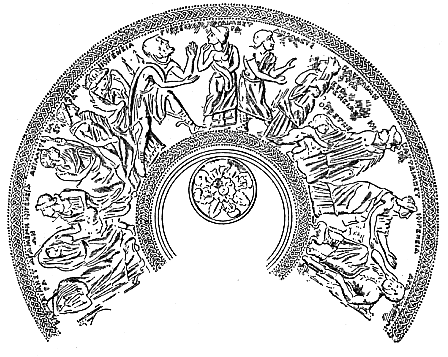
Figure 16 |
The Chalkian women, who through curiosity had crossed the
Euripos to see the gathered hosts of the Greeks, are ready at
hand to assist Iphigeneia in alighting from the chariot. The
lad Orestes, who appears to have gone to sleep during the
journey, is awakened and lifted down by one of the kindly
strangers. With her mother's permission, Iphigeneia hastens
inside to meet her father - She, innocently happy over the
arrival of her wedding day — he, overcome with grief at
her impending death, and smitten with remorse at the enormity
of his crime.
This much renders plain the group on the right.
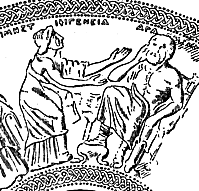 |
Agamemnon, ΑΓΑΜΕΜΝΩΝ, sits upon his θρονος with one foot on a foot-rest ; his right hand is placed to his temple as though to shut out the gaze of Iphigeneia, ΙΦΙΓΕΝΕΙΑ, who approaches him in a beseeching manner with extended arms. The group is based upon vs. 644 ff.
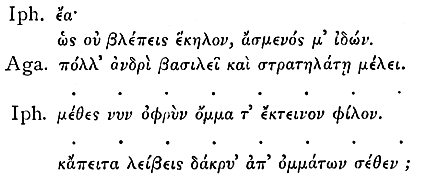 |
Such is the situation described by the poet, and surely the artist has succeeded to a considerable degree in grasping the meaning of the scene.
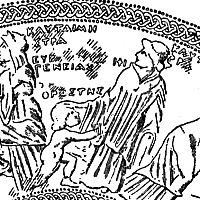 |
Klytaimestra,
ΚΛΥΤΑΙΜΗΣΤΡΑ,
appears on the left with Orestes,
ΟΡΕΣΤΗΣ, and would
seem to have had the boy in charge after he was helped from
the chariot (vs. 621 f.). Following is the inscription,
ΕΥΡ[ΙΠΙΔΟΥ]
ΙΦΙΓΕΝΕΙΑΣ.
The genitive case in the last word may depend upon some such
word as τυποι. To avoid a
possible misunderstanding of the scenes, even with the
characters named each time, the artist considered it
advisable to add the literary source. This is the
Iphigeneia of Euripides and not of any other
poet.
After Iphigeneia leaves her father he endeavours to persuade
Klytaimestra to return to Argos and leave the final
arrangements for the nuptials in his charge. Naturally enough
she refuses, and retires to appear at v. 819, where she meets
Achilles and enthusiastically brings up the subject of the
marriage. Achilles, amazed at the disclosure, assures the
queen that he has neither wooed Iphigeneia nor heard aught
from the Atreidai concerning any such an
alliance.
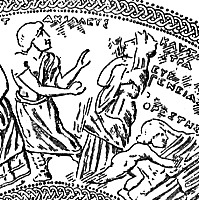 |
This scene is represented in the next group. Achilles, ΑΧΙΛΛΕΥΣ, bends toward Klytaimestra and gestures emphatically. The latter holds her hand to her chin and is evidently dumbfounded by the declarations. The last words exchanged before the two separate are suggestive :
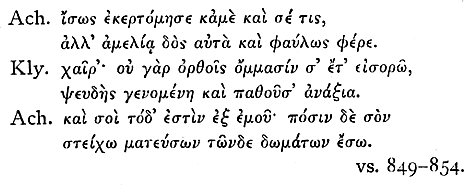 |
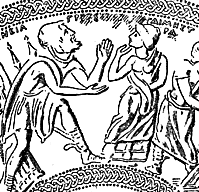 |
Immediately after these words the faithful old servant of
Agamemnon comes out and relates to Klytaimestra that
Iphigeneia is to be slain by her father ; he goes further and
tells the cause of it all, and how he had failed to get away
to Argos with the letter. This meeting of the servant,
ΠΡΕΣΣΒΥΣ, and
the queen, is dramatically told in the third group. The
former wears the costume of a pedagogue, with
peculiar-looking boots. The latter has laid aside the veil
which she wears in all the other scenes.
The following groups on the relief reverse the order of the
text, so it is best to consider first that on the extreme
left.
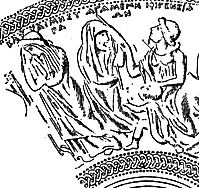 |
Agamemnon, Klytaimestra, and Iphigeneia are all named. The Young Orestes pulls at his father's chiton ; the latter has a mantle over his head, and shields his face with his left hand. The mother has turned aside and is consumed with her deep sorrow. She had won the sympathy of Achilles after the talk with the old servant, vs. 896-1035, and following the choral song appears again to seek Agamemnon whom neither she nor Iphigeneia had seen since the terrible truth of the marriage was disclosed. She calls her daughter from the house, v. 1117, and bids her
All of these figures occur on the cup, so that in a certain sense the whole scene from v. 1122 to v. 1275 is illustrated. The position of Klytaimestra and Iphigeneia would, however, lead one to think that the latter's long appeal was particularly in the mind of the artist. She recounts in words, as eloquent as they are pathetic, the promises her father had once made to her as a child, and goes over all the ambitions that had filled her girlish heart in the happy Argive home.
 |
There is certainly inspiration enough in these verses for a more pretentious group than the simple terra cotta cup presents, but lacking all other Greek monuments bearing upon this scene one may prize this witness as a valuable inheritance from the Hellenistic period. Agamemnon speaks ; he loves his child and realizes full well the meaning of the sacrifice, but he must obey the clamourings of the Greeks.
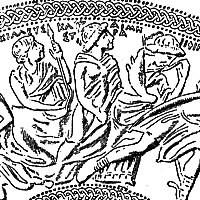 |
Iphigeneia and her mother remain alone with the chorus and bewail the bitterness of their sorrow, vs. 1276-1345, when a company of men is observed approaching. Among them is Achilles. His attempt to intercede in behalf of the doomed Iphigeneia had been of no avail. The Achaeans were inexorable ; her blood must be spilt. Nevertheless he promises them his assistance, and encourages Klytaimestra to resist Odysseus and the others who come to drag her daughter away to the altar, vs. 1338-1433. The early part of this scene is recognizable in the remaining group.
 |
Achilles stands with staff in hand, either about to
address the mother or perhaps having uttered the last verse
above. Iphigeneia turns with bowed head to avoid his presence
; her mother evidently tries to detain her. Inscriptions
again indicate who the persons are. We have then precisely
the situation in the lines quoted.
The sacrifice which followed, was attended by the marvellous
wonder, and it was to be expected that if any one
incident of the tragedy was told in art it would be the scene
at the altar. Our little monument curiously enough stops
where all the others begin. We are taken step by step up to
the final act and there we are left. The works enumerated
above are, without exception, confined to the moment of the
sacrifice. The famous Wall painting and the Florence altar
have much in common with the renowned painting of Timanthes,
and all three are conceived in the spirit of Euripides as far
as the actions of Agamemnon are concerned.
 |
And so he stands completely wrapped in his mantle, exposing no part of his face. In this invention lay the unsurpassed success which Timanthes enjoyed with his painting. The dates for this artist allow us to place the work subsequent to the production of the Iphigeneia in 405 BC., and credit Euripides with influencing Timanthes. This is at least possible, but does not admit of proof. It appears to me very likely that all three of these works are more or less closely connected with each other and with Euripides. The Etruscan ash urns on the other hand, as well as the vase painting in the British Museum, follow a totally different version of the story. In these cases Agamemnon himself takes the part of the priest in the ceremony, and performs the απαρχαι. So far from being the tender-hearted father who cannot even stand and watch the offering, he draws the fatal knife or pours the sacrificial liquid upon the victim's head. Traces of this turn arc found early in tragedy, but this is an Agamemnon with a far different heart from the one we follow in the Iphigeneia of Euripides. Even though the part from v. 1532 till the close of the play be thrown out as an interpolation, the character of Agamemnon in the first 1500 verses could not have changed so suddenly at the end that he would, have taken the place of Kalchas at the altar. This set of monuments does not, therefore, give us the Euripidean spirit.
Extrait de la monographie de John Huddilston - Greek tragedy in the light of vase paintings - London, Macmillan and Co (1898)